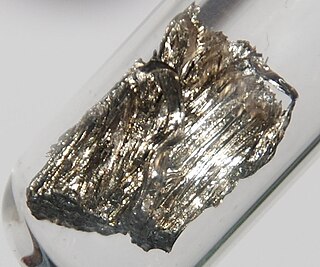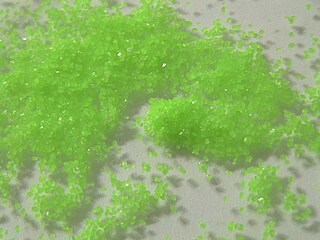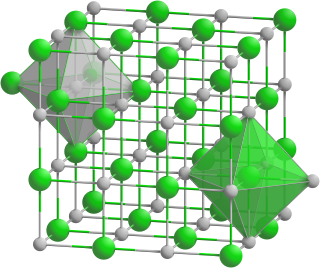
Samarium is a chemical element; it has symbol Sm and atomic number 62. It is a moderately hard silvery metal that slowly oxidizes in air. Being a typical member of the lanthanide series, samarium usually has the oxidation state +3. Compounds of samarium(II) are also known, most notably the monoxide SmO, monochalcogenides SmS, SmSe and SmTe, as well as samarium(II) iodide.

Freieslebenite is a sulfosalt mineral composed of antimony, lead, and silver. Sulfosalt minerals are complex sulfide minerals with the formula: AmBnSp. The formula of freieslebenite is AgPbSbS3.
Tin(II) sulfide is a chemical compound of tin and sulfur. The chemical formula is SnS. Its natural occurrence concerns herzenbergite (α-SnS), a rare mineral. At elevated temperatures above 905 K, SnS undergoes a second order phase transition to β-SnS (space group: Cmcm, No. 63). In recent years, it has become evident that a new polymorph of SnS exists based upon the cubic crystal system, known as π-SnS (space group: P213, No. 198).

Praseodymium(III) sulfate is a praseodymium compound with formula Pr2(SO4)3. It is an odourless whitish-green crystalline compound. The anhydrous substance readily absorbs water forming pentahydrate and octahydrate.
Phosphorus selenides are a relatively obscure group of compounds. There have been some studies of the phosphorus - selenium phase diagram and the glassy amorphous phases are reported. The compounds that have been reported are shown below. While some of phosphorus selenides are similar to their sulfide analogues, there are some new forms, molecular P2Se5 and the polymeric catena-[P4Se4]x. There is also some doubt about the existence of molecular P4Se10.

Cerium nitrate refers to a family of nitrates of cerium in the +3 or +4 oxidation state. Often these compounds contain water, hydroxide, or hydronium ions in addition to cerium and nitrate. Double nitrates of cerium also exist.

Triphenylphosphine selenide is an organophosphorus compound with the formula (C6H5)3PSe. It is a white solid which is soluble in most organic solvents. The compound is used in the preparation of other selenium compounds and is itself prepared by the reaction of triphenylphosphine with potassium selenocyanate. Single crystals have been isolated with both monoclinic and triclinic structures (space groups: P21/c and P1 respectively); in both cases the geometry at phosphorus is tetrahedral.
The phosphidosilicates or phosphosilicides are inorganic compounds containing silicon bonded to phosphorus and one or more other kinds of elements. In the phosphosilicates each silicon atom is surrounded by four phosphorus atoms in a tetrahedron. The triphosphosilicates have a SiP3 unit, that can be a planar triangle like carbonate CO3. The phosphorus atoms can be shared to form different patterns e.g. [Si2P6]10− which forms pairs, and [Si3P7]3− which contains two-dimensional double layer sheets. [SiP4]8− with isolated tetrahedra, and [SiP2]2− with a three dimensional network with shared tetrahedron corners. SiP clusters can be joined, not only by sharing a P atom, but also by way of a P-P bond. This does not happen with nitridosilicates or plain silicates.

Germanium tetrabromide is the inorganic compound with the formula GeBr4. It is a colorless solid that melts near room temperature. It can be formed by treating solid germanium with bromine, or by treating a germanium-copper mixture with bromine:

Doyleite is a rare aluminum trihydroxide mineral named in honor of its discoverer, the Canadian physician Earl Joseph (Jess) Doyle. It was first definitively described in 1985 and it is approved by the IMA. It was described from Mont Saint-Hilaire, where it is extremely rare.
Samarium(III) phosphide is an inorganic compound of samarium and phosphorus with the chemical formula SmP.

Lanthanum phosphide is an inorganic compound of lanthanum and phosphorus with the chemical formula LaP.
Samarium(III) arsenide is a binary inorganic compound of samarium and arsenic with the chemical formula SmAs.

Manganese lactate is an organic chemical compound, a salt of manganese and lactic acid with the formula Mn(C3H5O3)2. The compound forms light pink crystals, soluble in water, forming crystalline hydrates.
Phosphide iodides or iodide phosphides are compounds containing anions composed of iodide (I−) and phosphide (P3−). They can be considered as mixed anion compounds. They are in the category of pnictidehalides. Related compounds include the phosphide chlorides, arsenide iodides antimonide iodides and phosphide bromides.
Phosphide bromides or bromide phosphides are compounds containing anions composed of bromide (Br−) and phosphide (P3−) anions. Usually phosphorus is covalently connected into more complex structures. They can be considered as mixed anion compounds. They are in the category of pnictidehalides. Related compounds include the phosphide chlorides, phosphide iodides, nitride bromides, arsenide bromides, and antimonide bromides.
Samarium compounds are compounds formed by the lanthanide metal samarium (Sm). In these compounds, samarium generally exhibits the +3 oxidation state, such as SmCl3, Sm(NO3)3 and Sm(C2O4)3. Compounds with samarium in the +2 oxidation state are also known, for example SmI2.
Samarium(III) nitride is a binary inorganic compound of samarium and nitrogen with the chemical formula SmN.
Zirconium diphosphide is a binary inorganic compound of zirconium metal and phosphorus with the chemical formula ZrP2.
Praseodymium pentaphosphide is a binary inorganic compound of praseodymium metal and phosphorus with the chemical formula PrP5.








